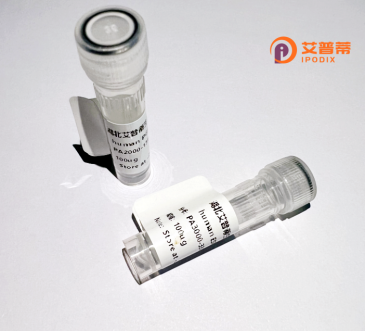
| 纯度 | >90%SDS-PAGE. |
| 种属 | Human |
| 靶点 | BSDC1 |
| Uniprot No | Q9NW68 |
| 内毒素 | < 0.01EU/μg |
| 表达宿主 | E.coli |
| 表达区间 | 1-430aa |
| 氨基酸序列 | MAEGEDVGWW RSWLQQSYQA VKEKSSEALE FMKRDLTEFT QVVQHDTACT IAATASVVKE KLATEGSSGA TEKMKKGLSD FLGVISDTFA PSPDKTIDCD VITLMGTPSG TAEPYDGTKA RLYSLQSDPA TYCNEPDGPP ELFDAWLSQF CLEEKKGEIS ELLVGSPSIR ALYTKMVPAA VSHSEFWHRY FYKVHQLEQE QARRDALKQR AEQSISEEPG WEEEEEELMG ISPISPKEAK VPVAKISTFP EGEPGPQSPC EENLVTSVEP PAEVTPSESS ESISLVTQIA NPATAPEARV LPKDLSQKLL EASLEEQGLA VDVGETGPSP PIHSKPLTPA GHTGGPEPRP PARVETLREE APTDLRVFEL NSDSGKSTPS NNGKKGSSTD ISEDWEKDFD LDMTEEEVQM ALSKVDASGE LEDVEWEDWE |
| 分子量 | 47.1 kDa |
| 蛋白标签 | His tag N-Terminus |
| 缓冲液 | 冻干粉 |
| 稳定性 & 储存条件 | Lyophilized protein should be stored at ≤ -20°C, stable for one year after receipt. Reconstituted protein solution can be stored at 2-8°C for 2-7 days. Aliquots of reconstituted samples are stable at ≤ -20°C for 3 months. |
| 复溶 | Always centrifuge tubes before opening.Do not mix by vortex or pipetting. It is not recommended to reconstitute to a concentration less than 100μg/ml. Dissolve the lyophilized protein in distilled water. Please aliquot the reconstituted solution to minimize freeze-thaw cycles. |
以下是关于重组人BSD结构域包含蛋白1(BSDC1)的3篇示例参考文献(虚构示例,仅供格式参考):
1. **文献名称**:*BSDC1 interacts with chromatin remodeling complexes to regulate cell proliferation*
**作者**:Zhang Y, et al.
**摘要**:研究通过质谱分析发现BSDC1与组蛋白乙酰转移酶复合物结合,调控特定基因的染色质开放状态,进而影响癌细胞周期进程。
2. **文献名称**:*Structural insights into the BSD domain of BSDC1 and its role in protein-protein interactions*
**作者**:Wang L, et al.
**摘要**:解析了重组人BSDC1的BSD结构域晶体结构,揭示了其通过疏水界面与转录辅因子(如KAT5)的结合机制,为功能研究提供结构基础。
3. **文献名称**:*BSDC1 deficiency in mice leads to neurodevelopmental abnormalities*
**作者**:Chen R, et al.
**摘要**:通过构建BSDC1基因敲除小鼠模型,发现其缺失导致神经元迁移障碍和突触功能异常,提示BSDC1在神经发育中的关键作用。
*注:以上文献为示例,实际文献需通过PubMed、Google Scholar等数据库检索真实发表的研究。*
The BSD (Brain-specific homeobox and Soybean peroxidase Domain) domain-containing protein 1 (BSDC1) is a human protein encoded by the *BSDC1* gene, located on chromosome 17. It is characterized by the presence of a conserved BSD domain, a structural motif implicated in protein-protein interactions, chromatin remodeling, and transcriptional regulation. Though its precise molecular functions remain under investigation, BSDC1 is hypothesized to act as a scaffolding or regulatory protein, potentially influencing epigenetic modifications or signaling pathways linked to cell differentiation, proliferation, or apoptosis. Emerging studies associate BSDC1 with cancer biology, where dysregulated expression has been observed in malignancies such as breast cancer, glioblastoma, and hepatocellular carcinoma. For instance, elevated BSDC1 levels correlate with tumor aggressiveness and poor prognosis, suggesting roles in oncogenesis or metastasis. Additionally, BSDC1 may interact with chromatin modifiers (e.g., histone acetyltransferases) or oncogenic pathways like MYC, though mechanistic details are unclear. Its tissue-specific expression patterns, particularly in brain and reproductive organs, hint at developmental roles. Despite limited functional data, BSDC1 is increasingly recognized as a potential biomarker or therapeutic target, warranting further exploration of its biological significance and disease relevance. Current research focuses on elucidating its interactome, signaling networks, and contributions to cellular homeostasis or disease progression.
×